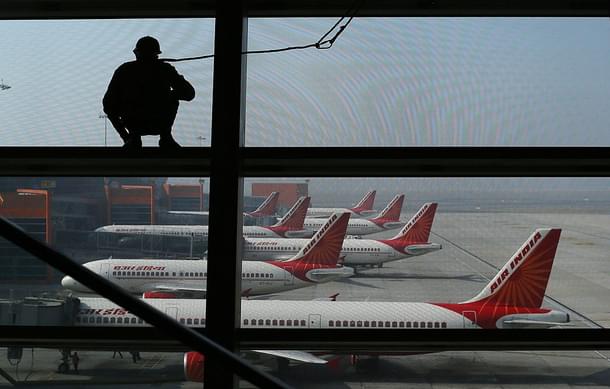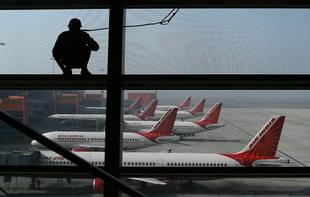Ideas
Hawai Chappals On Hawai Jahaj? Why UDAN Will Not Work As Expected
Shreyas Bharadwaj
Oct 22, 2016, 06:17 PM | Updated 06:17 PM IST
Save & read from anywhere!
Bookmark stories for easy access on any device or the Swarajya app.


A few months back, this writer had come up with three proposals that were aimed at helping the civil aviation sector realise its full potential.
The three suggestions to the newly-appointed Minister of State for Civil Aviation Jayant Sinha were, remove the remnants of the 5/20 policy, scrap the market distortive Regional Connectivity Scheme (RCS) and resolve confusion about the foreign direct investment (FDI) norms in the sector.
Here are the reasons for the three proposals
First, it is confusing why the 5/20 policy was introduced in the first place, as today it is being defended by the established players in the sector using the logic – we suffered for almost a decade due to this policy, and we want the new players to suffer similarly.
Second, the RCS is a brilliant way to get media attention, while at the same time, accomplishing little more than increasing airfares on existing routes. The scheme seeks to cross-subsidise via Viability Gap Funding (VGF), traffic on new regional routes by imposing a levy on those flying in Category 1 routes (the routes which witness most of India’s air traffic) through the establishment of a regional connectivity fund (RCF). The fare cap of Rs 2,500 drew a lot of media attention.
Third, the relaxations to the FDI norms in the aviation sector was followed by a period of confusion arising from the fact that though the FDI now allowed in the sector is 100 per cent, substantial ownership and effective control norms effectively require Indian management and control to remain with them. Why should we believe that investors would be falling over each other to put in money without having proper control over how it is spent?
The RCS was launched on the 21 October by the government under the name Ude Desh Ka Aam Naagrik (UDAN). In what has become a pattern for this government, RCS was also referred to as market oriented (which it definitely isn't, as usual). Only the broad idea of RCS was given to us in the National Civil Aviation Plan released earlier this year. The fineprint was revealed on 1 July with the release of the draft plan. The final policy document doesn't add much to the draft.
Here are the details:
Entrepreneurs have to submit proposals to operate aircraft or helicopters on routes, which are as yet not utilised. These proposals are to be submitted to the ‘implementing agency’, which will be identified by Ministry of Civil Aviation. For now, the ministry has decided that the Airports Authority of India will be the implementing agency.
This agency will then put forward the proposal for auction through a reverse bidding mechanism after which the route shall be awarded to those who offer the lowest bid. The initial proposer will have the right of first refusal on matching the lowest bid, if their original bid is within 10 per cent of the lowest bid.
The selected airline operator will have a monopoly on that route for a period of three years (How is it justified to be market oriented?)
The selected operator, if flying a fixed-wing aircraft, will be required to provide a minimum of nine seats and a maximum of 40 on the proposed route via UDAN rates i.e. at a maximum of Rs 2,500. The requirements are different for helicopter operators.
Meanwhile, participating state governments (excluding states in the North East) are not only required to come in for 20 per cent of the viability gap funding, but also required to provide a host of tax and indirect incentives. They will also be responsible for land costs and other supporting infrastructure costs. Tax incentives provided in this manner will be exclusive to UDAN operators on routes for which they have been selected.
The RCF, set up for the viability gap funding, will be funded through a levy on domestic air routes, which are not a part of the UDAN scheme.
As mentioned earlier, it is confusing why the 5/20 policy was introduced. The policy took its own life after it was launched, as already functioning airlines started benefitting from reduced competition from new airlines due to the scheme. Some airlines which initially opposed the policy, came to support it as they neared the five-year mark, which would allow them to operate on international routes. I expect something similar to happen with UDAN.
As usual, our politicians and bureaucrats will fulfill their grand visions by extorting the rest of us. Given the way the policy is designed, we should expect steady increases in the percentage levy on the fares on non-UDAN domestic air routes. Even if not many operators submit proposals, it is reasonable to expect that the government will use the money extorted from customers in this manner to fund a wastefully premature airport infrastructure building programme in tier 2 and tier 3 cities.
The scheme is subject to a three-year review after which some routes are supposed to be viable. It is only natural for connected politicians and realtors to enter this sector and lobby through this scheme for special incentives from state governments to ply on these routes. Regulatory capture is bound to happen. The only question is how soon can we expect to witness this?
Jayant Sinha has been mostly silent on the above mentioned issues except for his remark on the RCS during the launch programme of the scheme – “The idea of the scheme is to get those who wear hawai chappals on to hawai jahaj (aeroplanes)”.
While this author is extremely doubtful about those wearing hawai chappals getting on to hawai jahaj, one thing is certain – UDAN is ensuring that a lot of taxpayer money goes down the drain.
Shreyas Bharadwaj is a Hindutvawadi from Mysuru who is interested in writing about cities and public policy.





